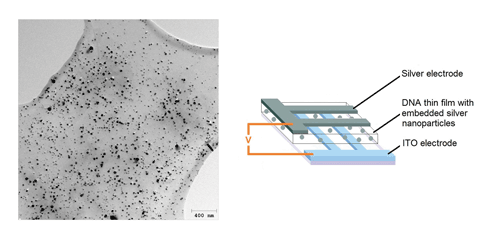Researchers use fish in chips to catch a better WORM
In an attempt to develop more cost-effective data storage, a group of researchers headed by Dr. Ljiljana Fruk from the DFG-Center for Functional Nanostructures (CFN) at the Karlsruhe Institute of Technology (KIT) in Germany and a group headed by Dr. Yu-Chueh Hungat at the National Tsing Hua University in Taiwan have created a write-once/read-mostly memory (WORM) IC using DNA from salmon. The research, which demonstrates the possibility of fabricating novel, cheaper, biofriendly devices, combines recent advances in DNA nanotechnology with a conventional polymer fabrication platform.
The heart of the device consists of silver nanoparticles embedded in a thin film of salmon DNA. Such DNA is a good template for metal polymer-nanoparticple (NP) synthesis because of its affinity to the metal ions. The NP film is then sandwiched between two electrodes (see figure ).

The TEM image at left shows light-triggered silver nanoparticle formation using a salmon DNA template. The film was integrated in the memory device design seen at right. (Photo courtesy of CFN, Dr. Ljiljana Fruk.)
Information is encoded by shining ultraviolet light on the system, which causes the silver atoms to cluster into nano-sized particles which provide the basis of the data encoding. The device can hold charge under a low current, which corresponds to its off-state. Under a high electrical field, the charges pass through the device, which then corresponds to the on-state the device.
The Taiwan team found that once the system had been turned on, it stayed on. Changing the voltage across the electrodes did not change the system’s conductivity, so information can be written to the device but not overwritten. Once written, the device appears to retain that information indefinitely. The researchers report that the material’s conductivity did not change significantly during nearly 30 hours of tracking.
Collaboration on the device started over a year ago, with researchers at the CFN involved in developing light-triggered, DNA-templated nanoparticle production and characterization, while the group in Taiwan optimized the process and designed the functional memory device. Transmission electron microscope (TEM) images of the nanoparticles in the DNA were obtained by the Nanostructure Service Laboratory in the CFN.
The researchers expect the technique to be useful in designing optical storage devices, and suggest it may also have plasmonic applications. For further information, contact Dr. Ljiljana Fruk at ljiljana.fruk@kit.edu.
Richard Comerford
Advertisement
Learn more about Karlsruhe Institute for Technology (KIT), DFG-Center for Functional Nanostructures





